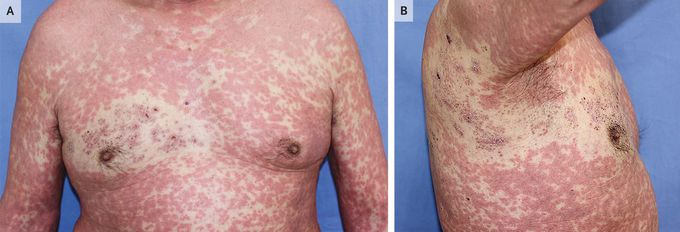


Reverse Isotopic Response
A 77-year-old man presented with a 2-day history of a diffuse rash that spared an area of skin on his right torso. Two weeks before presentation, herpes zoster infection had developed on the right side of his body over the T3 and T4 dermatomes, and he had received treatment with a 1-week course of valacyclovir. Ten days before presentation, he had begun taking celecoxib daily to treat new-onset back pain. On examination, there was a coalescing, erythematous eruption that spared the skin surrounding crusted herpes zoster lesions (Panel A shows the frontal view, and Panel B the right lateral view). Skin-biopsy results were consistent with a drug rash, and patch testing identified celecoxib as the trigger. A diagnosis of a reverse isotopic response in a drug rash sparing a healed herpes zoster infection was made. A reverse isotopic response — also called an isotopic nonresponse — occurs when a new skin disorder spares the area of skin previously affected by an unrelated, healed dermatosis. The mechanism of this phenomenon remains unclear. Treatment with a course of oral glucocorticoids was initiated, and the patient was advised to stop taking celecoxib. At follow-up 10 days after treatment with glucocorticoids began, the diffuse rash had completely resolved.

